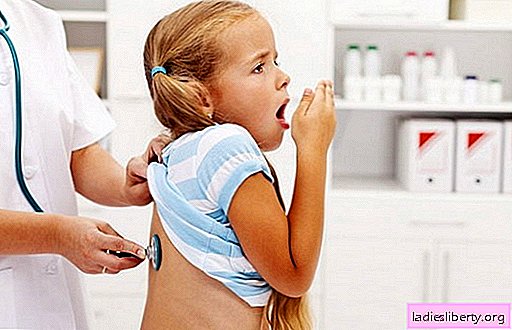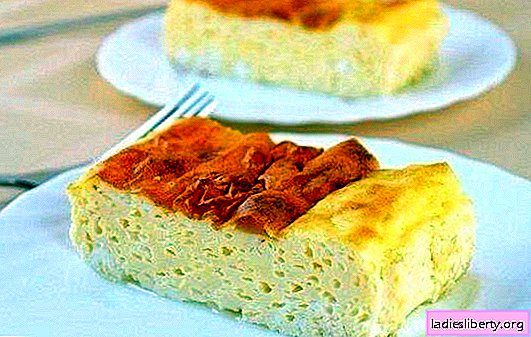
Dry tearing cough, which does not bring relief to the baby, causes the parents to desire to immediately alleviate the suffering of the child.
Unfortunately, you won’t be able to do this with lightning speed, but by determining the cause of the cough and taking the necessary steps, you can significantly speed up the healing process.
What is a cough?
Cough is a protective reflex with which the body tries to get rid of unnecessary contents - a foreign body, particles of dust, microorganisms, mucus. The coughing process begins with irritation of the respiratory tract. It consists of a deep breath and a tense jerky exhalation, the speed of which is several times higher than usual. If sputum or mucus does not occur, doctors call it dry. A cough can appear in a child at any age, and painful attacks sometimes exhaust him to the limit.
Cough can be rare and frequent, painful or not, constant or episodic, vary in sound and time of occurrence (night or day). In itself, this unpleasant process cannot accurately signal a specific disease, since it is inherent in many of them. To correctly determine the cause of the cough, it is necessary to take into account other concomitant symptoms, the history of its occurrence, the presence of patients with similar symptoms in the environment of the baby.
Types of dry cough in a child
According to the time interval, cough is divided into:
- acute - lasts no more than three weeks;
- protracted - its duration can reach three months and there is a real danger of the transition of the disease into a chronic form;
- chronic - constant and intrusive, it is impossible to get rid of it for more than three months. Attacks may not be so strong, but they annoy a baby who is tired of coughing and may indicate rather serious diseases - bronchial asthma, tuberculosis, chronic bronchitis, and even lung tumors.
According to other signs, a dry cough is divided into barking and prolonged, superficial or deep, pulmonary. The most dangerous, requiring immediate intervention, is the first, so you should dwell on this type of cough in more detail.
Barking cough in a child - reasons and how to help
This type of cough can cause many diseases:
1. whooping cough - due to vaccinations is now not very common;
2. pharyngitis or laryngitis - an inflammatory process in the mucous membrane of the larynx and pharynx;
3. influenza and all kinds of respiratory viral infections in children with a tendency to allergies;
4. false croup - it is dangerous in that it can lead to swelling of the larynx and vocal cords when an infection or virus enters the body;
5. true croup - diphtheria, is also quite rare in the presence of preventive vaccinations.
Most often, a barking cough appears in babies from four months to five years. False croup may be the first sign of SARS or the flu, but more often appears a few days after infection. The anatomical structural features of the larynx of children under five years of age give the possibility of laryngeal edema under the pressure of viruses. The clearance for air penetration narrows significantly, and the little sufferer begins to choke. In this case, you can’t do without qualified help from doctors, so mom urgently needs to call the ambulance. Dangerous symptoms:
- elevated temperature;
- excruciating barking cough;
- hoarse voice or its complete loss;
- the pallor of the baby;
- shortness of breath;
- wheezing;
- night attack with signs of suffocation.
The doctor will definitely carry out all the necessary diagnostic methods and prescribe treatment. If you need to place a young patient in a hospital, you should not risk his life and refuse, trust experienced professionals.
Attention! Before the doctor arrives and the diagnosis is established, you can not self-medicate, this can cause an even more powerful allergic reaction. However, it is possible to alleviate the condition of a small patient - pick it up, calm it, release clothes from the tightness of the chest, give it a drink with any warm drink, make a warm foot bath. The air in the room should be comfortable, warm and humid - you can hang wet towels on the batteries and put containers with water.
Long-term dry cough in a child
A deep pulmonary cough is clearly visible with the naked eye - the rib cage literally walks with a shiver, and the baby bends in half. The attack lasts quite a long time - from a minute or more, and takes away all the strength. Most often, this type of cough indicates the presence of bronchitis or pneumonia, but only a doctor can confirm the diagnosis and prescribe a course of antibiotics.
Sometimes, in the absence of wheezing in the lungs, it is necessary to make an X-ray to clarify the diagnosis - the cause of dry pulmonary cough may be covered by the presence of a chlamydial or mycoplasma infection in the lungs. Do not be afraid of a familiar name from advertising - these chlamydia are not at all the ones that gynecologists fight with. They are contained in ordinary air and are treated with the same drugs as pneumonia. However, a cough caused by chlamydia can still torment for a rather long time - about three weeks, or even more.
Quite often, the diagnosis of chlamydial pneumonia is given to newborns. Its symptoms are a jerky and sonorous cough without fever and fever, but with a significant increase in breathing. Dry cough in infants can be caused by “choking”.
A superficial cough is not so painful; a mother who pities her baby suffers from it more. With this type of cough, the child’s voice often disappears, which indicates an inflammatory process in the larynx region. But the attacks do not last as long as with the pulmonary form, and the sound of coughing pushes is much quieter. The main specialist in the treatment of superficial dry cough is an otolaryngologist. He will make the correct diagnosis, prescribe medication and local treatment. In this case, rinsing and inhalation can be of great importance.
Dry cough in a child without fever - why is it dangerous
Many young mothers, having heard the dry irritating cough of their baby, rush to measure the temperature. And this, of course, is correct. The mistake lies in another - making sure of its absence, many calm down, and there is a certain danger in it. Very often, attacks of dry cough in a small fidget are associated with the ingestion of a foreign body - peas, parts from the designer, a piece of cookie or candy in the larynx. A sharp onset of cough with some signs of suffocation indicates precisely such a development of events.
Much depends on composure and quick reaction of parents. Immediately, but without unnecessary panic, put the child on his knee so that the head and upper part of the body hang down. Having opened the mouth of the little one, you need to carefully tap with sliding movements from top to bottom between the shoulder blades. Usually the stuck item falls out, the cough disappears safely, but the doctor still seems worth it. The airways can be damaged and subsequently bring unpleasant surprises.
Night cough in a child
Another reason for seeking medical help is a night cough. At this time of day, not only viral infections and colds, but also more serious diseases can cause a dry cough:
- asthma, which attacks worsen at night. A distinctive feature is the whistling on the exhale;
- sinusitis, sinusitis, frontal sinusitis, adenoids and just a runny nose - when lying down, mucus can irritate the larynx and cause a cough;
- whooping cough, a sign of which is tension and redness of the face when coughing. Often the attack ends with vomiting;
- reverse casting of the contents of the children's stomach, accompanied by heartburn.
As you can see, a variety of diseases can serve as the cause of night cough, therefore, first of all, it is necessary to find out its cause, and only then take contractual measures.
Treatment of dry cough in a child
It is worth noting that the use of medications for the treatment of cough in children under two years of age is not recommended because of a possible overdose. Only in case of emergency, the doctor can prescribe droplets or syrup to a baby older than 2 months, but only in strictly calibrated doses. Children of any age should be given more warm drink - fruit drinks, jelly, tea with lemon and honey, if there is no allergy - decoctions of herbs. You can do inhalation, gargle with saline, and children after 4 years old suck on cough drops. In order to avoid the occurrence of allergies, it is advisable to coordinate your actions with your doctor.
To facilitate dry cough, you can use the recipes of our grandmothers:
1. Hold a spoonful of granulated sugar over the fire until the grains turn brown. Pour it into a small amount of milk and suck the lollipop from cough.
2. Pour a banana with sweet water, eat it warm.
3. Mix honey and olive oil. Drink 1 spoon 3 times a day.
4. Dilute milk with carrot juice, drink 3 times a day.
Do not ignore wet cleaning, regular ventilation and humidification.
What does Dr. Komarovsky say about dry cough in a child
Advice from Dr. Komarovsky - with ARVI with damage to the upper respiratory tract, in no case should mucolytics be used, this will only provoke the formation of profuse sputum and cause an even stronger cough.











